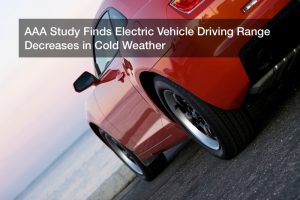
There are a lot of impressive vehicles on today’s roads — like ‘The Beast’, which is an armored Cadillac limo with a five-inch layer of armor that’s used to transport President Trump. But some of the more impressive vehicles available to normal folk are electric vehicles. Unlike the first stretch limousine, which made its debut in Arkansas over 90 years ago, these cars are doing wonders for both the environment and owner’s bank accounts. We’ve come a long way since GPS was first introduced in cars back in 1996. But a new AAA study found that cold temperatures can actually deplete electric car batteries.
The study looked at five different electric vehicles: the BMW i3s, the 2018 models of the Nissan Leaf ad the Chevrolet Bolt, and the 2017 models of the Tesla Model S 75 D and the Volkswagen e-Golf. All of these vehicles typically have at least 100 miles of driving on just one full charge. But with recent cold fronts and colder-than-normal temperatures, many electric vehicle owners noticed their battery range wasn’t as high as it usually is.
For the study, the five vehicles were tested on a dynamometer, which is basically a treadmill for cars, in an environment where the researchers could control the climate. Additionally, there are four main types of off-road tires: all-terrain, mud-terrain, snow/winter, and sand.
AAA tested the cars at an average 75 degrees Fahrenheit, then tested the car at 20 degrees and 95 degrees. The company found that at both significantly lower and higher temperatures, the average driving range fell. At 95 degrees, the driving range dropped 4% — this was without using air conditioning. When the car was cooled, the driving range dropped 17%.
And while those numbers alone are concerning, the range dropped even more when the cars were tested in 20 degree temperatures. When the heat was not used, the driving range dropped by 12% and when the heat was used, it fell 41%.
With only about 8.7% of households in the U.S. not having vehicles in 2016, there are more electric cars on today’s roads than ever before. And owners of electric vehicles are not happy about the reduced battery in the cold.
Hickory, North Carolina resident Jason Hughes said he noticed his Tesla Model 3’s driving range decrease at the beginning of February.
“It would easily use double the amount of power for that 15-mile trip,” claimed Hughes. “It’s definitely an issue. If you want to go somewhere far in the cold, you’re going to be using more power.”
But Tesla disagreed with AAA’s findings. In a recent statement, the automaker said “the average Model S customer doesn’t experience anywhere near that decrease in range.” The company claimed that in 95 degree weather, the range dropped by about 1%, but there was no percentage change when driving in the cold weather.
So while about 77% of cars on the roads today are in need of maintenance or repairs, electric vehicle owners have a new problem to be concerned about. Greg Brannon, AAA’s director of automotive engineering, said this could be an issue moving forward for EV automakers. As long as consumers are aware of these limitations, they should be able to drive in extreme weather conditions and be prepared. But EV automakers need to keep this in mind as they continue to develop electric vehicles so they can ensure their customers will be prepared for these potential problems.

